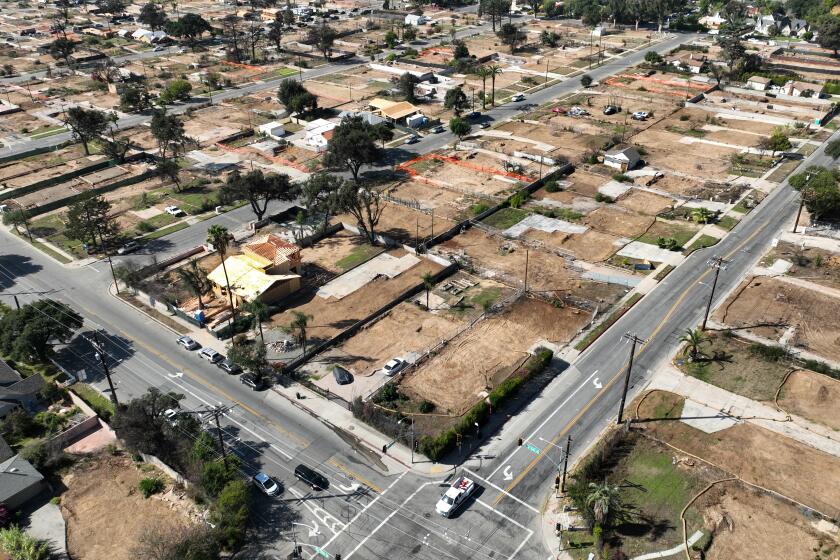After everything endured by victims of the Eaton and Palisades fires, they didn’t need yet another indignity, another gut punch, another reason to throw their heads back and scream.
But that’s exactly what they’ve gotten, with mounting evidence that in each of the historically destructive infernos, fumbles by fire department personnel contributed to disastrous consequences.
For months, there’s been legitimate outrage over staffing, preparation, strategies and resources. But in recent days, a couple of very specific breakdowns have been highlighted.
In the case of the Eaton fire, my Times colleagues Grace Toohey and Terry Castleman reported Saturday that as the blaze spread on the evening of Jan. 7, firefighters in the field urged a broader evacuation. But the orders were delayed by three hours in West Altadena, where 18 people died and numerous residents raced for their lives as thousands of homes were incinerated.
“It’s another slap in the face,” said Zaire Calvin, a lifelong West Altadena resident who lost his sister, his home and his neighborhood in the fire. “There was a full breakdown, we know that for sure. It’s why everybody on the west side was like, we have to save ourselves.”
In the case of the Palisades blaze, Times staffers Alene Tchekmedyian and Paul Pringle reported last week that a review of texts reveals that firefighters warned a battalion chief that a New Year’s Day brush fire still was smoldering the next day. But they were ordered to leave the area, and federal authorities said five days later the fire reignited, killing 12 people and displacing thousands.
Read more: Days before Palisades inferno, firefighters were ordered to leave smoldering burn site
“It’s a complete sucker punch,” said Jewlz Fahn, who lost her home in the Palisades, as did her parents and sister.
She was livid that the Los Angeles Fire Department did not use thermal imaging technology to detect underground embers, as reported by The Times, and then abandoned the brush fire location despite warnings by front-line crew.
“It is astounding to me,” Fahn said. “So it wasn’t because the winds were too strong and they couldn’t put out the fire. Had they stayed in the area like they should have and had they used heat-detecting technology … they could have avoided this.”
News of the delayed evacuation warnings in West Altadena surfaced in a $1.9-million report that was roundly criticized by residents, and even the county supervisors who ordered it, for failing to provide clear accountability and responsibility for delayed evacuation orders.
Supervisor Kathryn Barger told The Times the L.A. County Fire Department was responsible for “a gap” between the need for evacuation alerts and the delivery of them. “That was where the breakdown was,” she said.
County Fire Chief Anthony Marrone declined to be interviewed for the story on the three-hour gap, and a spokesperson said Marrone is “committed to ensuring the department continues to improve for future fires.”
Shawna Dawson Beer, who lost her Altadena home, is neither surprised by damning revelations about communication breakdowns nor appeased by claims that all is well going forward.
“We were just left to burn … and it’s so galling to have to continue to be gaslit by the county and L.A. County Fire,” said Dawson Beer, who is with a community group called Altadena for Accountability that has demanded a full investigation by the state attorney general.
“Let’s be honest,” she wrote on Substack. “Our resources were mismanaged. We were failed. And because [L.A County, the Fire Department and Southern California Edison] are so financially and politically intertwined, no one will take responsibility.”
There’s a lot of responsibility to consider, including utility company complicity and climate change conditions that have accelerated the threat of destructive fires around the world. As for the Paltadena conflagrations, heat and wind were major factors, and in the Palisades fire, 29-year-old Jonathan Rinderknecht was charged with setting the brush fire that eventually set off the killer blaze.
But on top of all that, human error is undeniable.
In the immediate aftermath of the Palisades fire, veteran chiefs told me and others they were all but certain that the small earlier fire sparked the bigger one, and they were proven right.
“I would say a majority of us who live in the Palisades knew it was a re-ignition. It was obvious from the get-go,” said Sue Pascoe, who lost her home and is the editor of the popular community publication Circling the News. Pascoe said in the past “homeless fires” were put out and would later smoke up again, and the Fire Department would be back to extinguish the embers.
Then came the January fire that wiped the Palisades off the map.
“I think what people are really upset about is that the firefighters knew about that, and they left anyhow,” Pascoe said, noting that the crew was following orders and wondering what others might have done in the same situation.
Read more: Firefighters urged mass Altadena evacuations. It took three hours for command center to act
L.A. Mayor Karen Bass ordered interim LAFD Chief Ronnie Villanueva to “thoroughly investigate” the revelations that firefighters were ordered to leave the site of the smoldering brush fire just days before it exploded into a monster blaze.
But that’s not good enough, said former deputy mayor and Los Angeles Unified Sschool District superintendent Austin Beutner, who is running to unseat Bass.
“Mayor Bass is asking the fire department to investigate itself,” Beutner said in a statement, calling on her to hand the job to an independent commission.
Beutner has been forced out of his smoke-damaged Palisades home since the fire, which destroyed his mother-in-law’s house. He told me he’s not running for mayor simply because of the fire, but because of what he called a failure of leadership on many fronts and a crisis of affordability for many residents.
The crisis extends to thousands who remain uncertain — amid ongoing delays and denials by insurance companies — whether they can afford to rebuild.
We don’t yet know what the Palisades or Altadena fires will become. What we know is that 31 people died, 16,000 structures were destroyed, and an untold number of people may never recover financially or psychically.
And we know, thanks to dogged reporting throughout the year, that mistakes were made and the cost is incalculable.
“The toll it’s taken on everyone is ripping families apart and taking away futures. … My mother is 85 and buried her daughter,” West Altadena’s Calvin said, adding that they’re not home yet and don’t know when they will be.
“The PTSD is real,” Altadena’s Dawson Beer said. “I’m not a delicate flower. I’m as tough as they come, and this is a lot. Many days, I don’t know.”
steve.lopez@latimes.com
This story originally appeared in Los Angeles Times.

